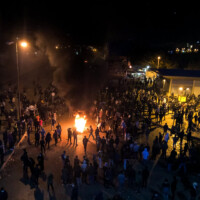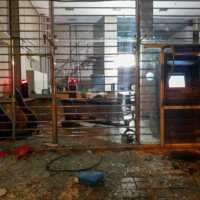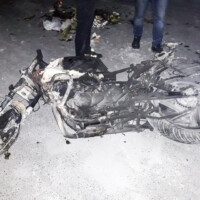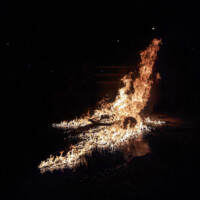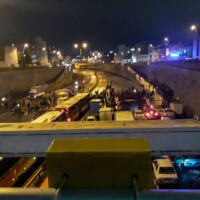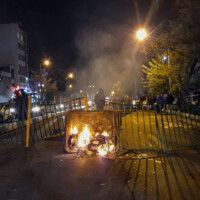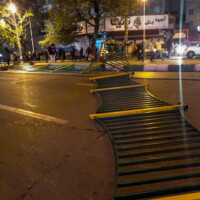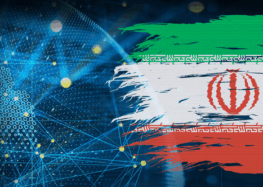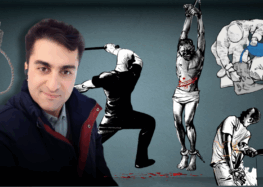Photos from Iran ‘Bloody November’ in 2019: The State Massacre Hidden by an Internet Blackout
 “November 2019 was one of the Islamic Republic’s most intense crackdowns…They managed to cover their tracks well.”
“November 2019 was one of the Islamic Republic’s most intense crackdowns…They managed to cover their tracks well.”
November 29, 2024 – To commemorate the fifth anniversary of Iran’s 2019 “Bloody November” protests—when the Islamic Republic gunned down mass numbers of unarmed protesters in the streets—the Center for Human Rights in Iran (CHRI) has partnered with Middle East Images to present a powerful collection of photographs that offer a glimpse into one of the most brutal state crackdowns on protesters in Iran’s modern history.
Sparked by a sudden increase in fuel prices, the 2019 protests quickly spread nationwide as Iranians took to the streets, expressing frustration not only over economic hardship but also over systemic corruption, political repression, and lack of freedoms.
The state responded with unprecedented violence: hundreds—if not over a thousand—were killed, more than 7,000 protesters were arrested, and untold numbers were injured, detained, disappeared, tortured, and sentenced in close-door trials. Not one Islamic Republic official has ever been held accountable for this illegal lethal violence.
During the protests, the Iranian authorities imposed a near-total internet shutdown for nearly a week to conceal the scale of the killings by security forces. As a result, much valuable footage and evidence of the state’s atrocities were lost.
These photographs, however, captured by brave Iranian photojournalists whose identities must remain confidential for their safety, managed to survive, offering a raw and intimate look at what unfolded in the streets of Iran when the country was plunged into darkness.
Hossein Fatemi, an award-winning Iranian photojournalist and director of the Middle East Images Agency, described how the internet shutdown made documenting the November 2019 protests so challenging. His team of photographers on the ground struggled to publish their work. One member had to smuggle the photos out of Iran on flash drives through Iraqi Kurdistan.
“When November 2019 unfolded, I was in Erbil, Iraqi Kurdistan. I quickly talked with our team on the ground, asking if they could document the protests, but then we lost connection. We didn’t know the protests were going to be so huge. One colleague, who had a connection at IRIB [Iran’s state-controlled Islamic Republic of Iran Broadcasting], managed to use their internet access and send a few frames. Another colleague came to Iraqi Kurdistan with a flash drive of photos, which we were able to edit and distribute to news agencies.
“When the Woman, Life, Freedom movement began, our experience from Bloody November had prepared us to cover it much more extensively. But in November 2019, not much was produced. The repression was extremely severe; photojournalists and photographers working on the ground were heavily suppressed to ensure that nothing leaked out.
“Fast forward to after they killed Mahsa [Amini, the 22-year-old killed in state custody for an allegedly improper hijab, which triggered the Women Life Freedom uprising]. I remember telling myself, ‘We’re not going to let another November 2019 happen.’ There had to be images that the world would recognize as symbols of this movement and uprising. In November 2019, we had no such images. When people think of ‘Bloody November,’ no iconic image comes to mind, unlike other movements in Iran. That’s why November was one of the Islamic Republic’s most intense crackdowns in its 45-year history. They managed to cover their tracks well.”
Through these images by three photographers who were on the ground in Iran during the November 2019 protests, along with recent remarks they shared with CHRI on their memories of Bloody November, you can witness both the resilience of the Iranian people and the brutal reality of state repression in the Islamic Republic, as Iranians continue their ongoing struggle for justice and human rights.
 “We were all struggling to breathe”
“We were all struggling to breathe”
“The protest atmosphere in the streets was very intense; people were chanting slogans protesting against injustice, corruption, and poor living conditions. As the protests intensified, security forces appeared in large numbers on the streets, attempting to control the protests by blocking roads and using tools like tear gas, water cannons, and live ammunition.
“The atmosphere was so heavy that I couldn’t take the camera out, so I started taking pictures with my phone of protesters who had set tires on fire. A remarkable number of people had gathered there. Protesters were covering their faces with masks, and under a bridge people were chanting under the leadership of a brave woman, and I began taking pictures.
“The Basij forces used tear gas to disperse the crowd. I saw three officers beat a woman with a baton, arrest her, and drag her away. The atmosphere was very tense, and people scattered because of the tear gas. We were all struggling to breathe; our eyes were watering, and it felt like we were going blind. A person who was smoking called me over, held my head, and blew cigarette smoke into my eyes. The Basij forces were still following us, and there was nowhere to go. Even the metro was closed to keep people from coming to this part of the city. Then I saw that a few Basij forces had shot a young man, around 17 or 18 years old, with live ammunition, and some friends or other protesters were carrying him.”
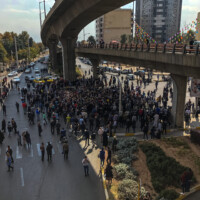
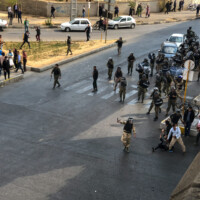

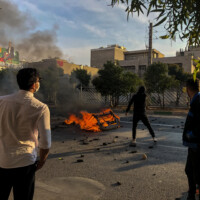

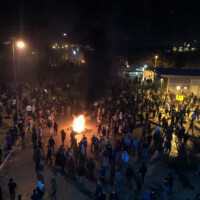

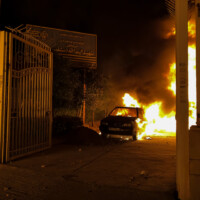

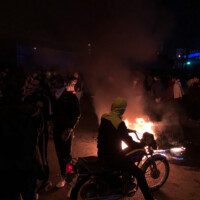
 “November was the uprising of Iran’s marginalized”
“November was the uprising of Iran’s marginalized”
“The tension was extremely high, as the streets were completely overtaken by the protesters. The police were subtly mingling with the crowds to identify and gather information. Confrontations turned more violent and reactive when people attempted to block highways. Tear gas was constantly deployed, filling the streets with a mix of tear gas smoke and smoke from objects set on fire to combat it, making it hard to breathe. It was complete chaos but there was also a complete sense of unity.
“The solidarity and cooperation among the protesters was huge. Some were lighting fires to counteract the tear gas, others were dismantling security cameras in public areas and banks, some were blocking streets, others were destroying banks, and others were chanting slogans.
“But the acts were controlled. Even with cars parked along the streets, not a single stone was thrown toward them. The focus was solely on police and financial symbols like gas stations and banks. November was the uprising of Iran’s marginalized.”
 “I saw many scenes of people being detained and taken away.”
“I saw many scenes of people being detained and taken away.”
“On the first day, I went and took photos. Even at that [early] point, I witnessed scenes of violence. For instance, in Sa’dat Abad Square [in Tehran], I saw seven to ten officers suddenly attacked someone with batons and boots, dragging them into a van. Security forces also fired tear gas directly at people using their pistols.
“They had blocked off areas from the other side of Sa’dat Abad Square, both the first and second roundabouts, preventing people from moving between the two or leaving the area. Anyone who tried to leave was severely beaten, and they kept everyone trapped in the middle.
I saw many scenes of people being detained and taken away. What was particularly striking was how much tear gas they used. Even four or five blocks away from the protests, you still couldn’t breathe properly because of it.”

